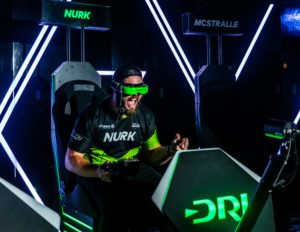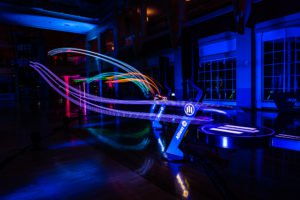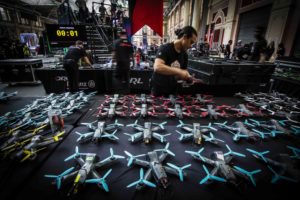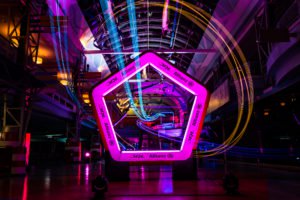Drone racing is one of the hottest sports on the horizon – and Paul Nurkkala is a champion. DRONELIFE gets an insider’s look at drone racing and the international Drone Racing League (DRL) with this in-depth interview, as Nurk talks about training, travel, and a day in the life of a drone racing hero.
DroneLife: Thanks for connecting with us. For those of us who may not be familiar with Drone Racing, can you tell us a little bit about it?
Paul Nurkkala: “Drone racing is a natural evolution of transportation. As soon as we could run, we raced; as soon as we could drive, we raced; and as soon as we could fly we raced. The same is true here of drone racing – it’s the natural next step of UAS. Drone racers utilize what we call “FPV” or “First Person View” to see from the perspective of the machine we’re flying – in the same way that an AP (Aerial Photography) drone might be viewed through a monitor or a phone, we have the ability to view the perspective of the drone from a fixed camera. Typically, FPV competitors will wear goggles over their eyes; this gives you a wonderful sense of perspective and makes you feel as if you’re onboard the machine. From that point, racing is as simple as it sounds – 3, 2, 1 go and the first person to the finish line wins. In the Drone Racing League, we have six competitors race their drones simultaneously, so collisions, passing, and proper timing are all key parts of executing a good race.”
DroneLife: What is the drone racing league and how does that work?
Paul Nurkkala: “The Drone Racing League (DRL) is an international circuit of professional drone races. DRL events are recorded for a post produced show that airs on NBC and NBCSN (and will air on Twitter live later this year). The league employs some of the best drone racers in the world, and we travel through the USA, Germany, France, and the middle east competing against one another.” (Note: DRL airs on premier broadcasts and streaming platforms all over the world, including Twitter, NBC, Sky Sports, ProSeiben, OSN, FOX Sports Asia, and Youku.)
DroneLife: How long have you been involved in drone racing, and how did you get started?
Paul Nurkkala: “I have been flying performance drones for about 4 years now. My first drone was a Walmart-grade toy that my in-laws bought me for Christmas in 2014. From the moment I started flying it, I was challenging myself – “Can I fly through this obstacle?” “Can I land on that spot?” Naturally, as such things go, I broke the drone. As an ex-software engineer, I figured – “hey- I should be able to fix this.” I went on the internet and got a YouTube University education on fixing drones, but at the same time stumbled across a video of drone racing. When I saw a particular video of a bunch of French guys racing through a forest, I remember having a distinct moment of “Well.. I have to do this now..””
DroneLife: I know that there are different types of drone racing. Which one (s) do you participate in?
Paul Nurkkala: “There are a few different types of drone racing to participate in, and I have competed in and love almost all. The discipline that I practice is simply individual, heads-up racing, meaning we are all for ourselves, and first to the finish line wins. However, you can also participate in team events, where you essentially run a relay race with a team of other racers, and the first to X number of laps will be crowned victor. There’s also a newer discipline called “X-Class” racing which consists of much larger machines running high speed on a simpler track. Each discipline is a small iteration of the same concept, and all are a blast to participate in.”
DroneLife: How did you develop /maintain the skills to be success? To what do you attribute your success? Why are you consistently successful?
Paul Nurkkala: “ I think any professional athlete would tell you that there’s no way around hard work. Prior to races, I practice with my drones for 8-10 hours a day. This is a full time job for me, so when I have an upcoming race, I drop everything and get on the grind to refine my lines and make myself as fast as I possibly can be. I simply realized that I don’t necessarily have a natural talent for being a fast, competitive racer, but I did know that I had the strength and discipline to put the work in to compete against the best. So the reason that I am consistently successful is that I know what I have to do to win, and I’m willing to put my nose to the grindstone and get it done.”
DroneLife: Did you play video games as a kid? Which ones? Do you think that it helped you in racing?
Paul Nurkkala: “I absolutely played video games as a kid. I started playing video games in the late 90s, so I was part of the nintendo 64 generation. Super Mario, smash brothers, and star wars games were my obsession. When I was old enough to purchase a computer, I switched to MMOs and shooter games, but always had a passion for racing games. As to whether or not video games helped me in racing, I couldn’t say. What I will say is that I never treated video games as something to achieve mastery – it was something fun and relaxing, and something that I could use to shut my brain down. As a result, I never treated video games with the discipline that I’ve used to help myself achieve success in drone racing. So yes, while I’m confident that the video games helped a bit with the hand-eye coordination required to compete with a drone, I wouldn’t say that my history of gaming has necessarily pushed me to where I am today.”
DroneLife: Drone Racing is a international sport, what cool places have you especially enjoyed and why?
Paul Nurkkala: “I think this is one of the coolest parts about drone racing for me. Drones have given me the opportunity to travel to places that I never thought I’d go. I’ve been all over the United States, Iceland, UK, Germany, France, China.. The list goes on.. I often still can’t believe it. But, no matter where I am, I always try to take a moment to reflect on my journey – without the hard work that I’ve done to achieve success, I would never have gotten to be wherever I was at that moment.”
DroneLife: In car racing they sometimes have a developmental league whereby pilots’ race in simulated environments. Does drone racing have the same thing?
Paul Nurkkala: “Drone racing absolutely does! DRL has created a drone racing simulator that is a 1:1 recreation of the way that drones fly (you can get the sim for $20 on Steam). This simulator hosts a tryout ever year, wherein people submit lap times across a designated track. If the competitors are able to achieve a certain lap-time threshold, they’re invited to an in-person esports tournament, where they’ll compete against one another to become the next pilot on the Drone Racing League series. This years champion Chris “Phluxy” Spangler won, and he has already started training for the 2019 season.”
DroneLife: How has drone racing changed in the time that you have been involved in it?
Paul Nurkkala: “I would say that since I started the two biggest changes in drone racing have been (1) technology and (2) “seriousness”. In an emerging market like drones, 5 years is a very very long time. Tons of software has been written, hardware developed, and products built to help drones fly better and better. The drones that we fly today outperform the drones we learned on 10 fold, and that has lead to many interesting opportunities for these little performance drones. (2) drone racing has started to become a viable career. When anything gets to the point that you can do it professionally, you start to treat it more seriously. In the same way that I have treated practice like a 9-5 job, many others are doing the same and are seeing a lot of success from that. Rather than drone racing being a niche hobby, it’s now becoming mainstream entertainment. Along with that comes a bit of an attitude change. I’m not saying that this is a bad thing, but it certainly can change the feel of how you approach a competition.”
DroneLife: Has the competition level increased as the sport has grown?
Paul Nurkkala: “The competition level within drone racing has wildly grown. 3 years ago, you could probably have named 1 in 10 guys that would almost inevitably win every single race that they attended. Today, that depth chart has widened greatly, and you can never plan on who is going to win a race. So many people are starting to push harder and harder, and it’s forcing those of us at the top to go harder and harder.”
DroneLife: How many people attend the events and how can people get involved in learning more about the sport?
Paul Nurkkala: “DRL is working towards enabling racing to being a live event. A fledgling sport like this requires a lot of care to make it work, but we’ve seen success. This year, at championships we had a live audience of around 4,000 people, and several other events have had attendance that also rose into the 1,000’s. As the sport grows, so will the audience. That being said, our worldwide broadcast audience is in 90 countries and reaches nearly 50 million people.”
The best way to learn about the sport is online. In the same way that I started through YouTube, I recommend that all others start there. If you learn how to build your drone and then learn how to fly, you’ll be able to fix your drone when things inevitably go wrong.
DroneLife: What advice would you give to racers just getting started?
Paul Nurkkala: “Stick time is key. The more time you fly, the more confident you come, which means you’ll fly more time and get better and better. When you’re starting, use a simulator to help get that stick time down. Buy an RC radio like a Taranis 9xd, plug it into the DRL simulator, and use that for infinite battery life, and unlimited propellers. When you start, you WILL CRASH A LOT! There’s no way around it, so don’t be afraid of crashing. The sooner you don’t care about crashing, the sooner you’ll be flying confidently.”
DroneLife: People are always interested in what other people’s lives are like. Can you please describe a day in your life? At an event and when you are not at an event?
Paul Nurkkala:
Non-event day:
Typically I get up around 8-9, assuming that I haven’t been traveling the day before. I make a TON of coffee (I drink it way to much), scratch my two doggos Kira and Kylo (both full-blood german shepherds), and get to work. Work for me can be a few different things.. I run a YouTube channel over at http://nurk.tv that has a bunch of vlogging, educational, and tutorial videos; I run two companies – one for videography, and one for event activation with drone racing; and finally I have to look after my racing career, which will include networking, phone calls, interviews, and searching for more opportunities. Every day until mid afternoon will consist of some subset of all of those. For the last few hours of my work, I’ll be charging batteries, and in the afternoon head out for practice. I’ll arrive at my flying field, spend 30 minutes building up a track, and then the next 4 hours I run as many batteries through the course as I can. When (1) it’s dark, or (2) I’ve killed all of my drones, I pack everything up and head home. I’ll spend time with my wife — we’ll cook, go for walks with the dogs, work out, and watch TV, and then head into my drone lab to fix those days’ broken drones until they’re ready. This can lead to some late nights, but it’s what I have to do to stay ready. I head to bed and wake up and repeat.
Event day:
These days can vary greatly, depending on the event and where it is, but I’ll make some assumptions: DRL event, evening shoot, on the road.
DRL often shoots overnight – so we’ll be on set from 8:00pm to 4-5:00 am, so first things first I’ve shifted my sleep schedule, and I HOPEFULLY won’t wake up until 3-4p at the earliest. I’ll find some breakfast and some coffee, and then head back to my room to study. We have the ability to record all of the things that we see in our goggles, so when I have practiced a track, I take that footage and study it and learn it. I look for places where I can take a turn different, apex later, push faster, etc, and memorize it. After about an hour of reviewing the footage, I spend 30 minutes forcing myself to visualize my way through the course – this means that I’m flying the course but only in my head. If I make a mistake, I start over, and I keep going until I get it right, remembering all of my clipping points, where to turn in, how to take an apex, etc. When I’ve finished visualization, I like to try to exercise a little bit.. Whether that’s running on the hotel treadmill or going for a long walk – I just want to get the blood flowing. Either way, I keep it very relaxed and keep my mind open, so that when I arrive on set, I’m ready to rock.
DroneLife: I notice that you have developed a cool web page for your fans to keep track of what you are up to – please share!
Paul Nurkkala: “There are a number of different places that you can keep up with me:
http://nurk.tv (youtube)
http://paulnurkkala.com (blog and about and contact and whatnot)
https://twitter.com/nurkfpv (twitter)
https://instagram.com/nurkfpv (instagram)
I would love and appreciate any follows you’d be willing to give!”
DroneLife: Outside of drone racing, what else do you do both personally and professionally?
Paul Nurkkala: This stage in my life pretty much exclusively revolves around drones. If I’m not racing, I’m building, freestyling (doing tricks and making videos with drones and gopros), and vlogging. My wife and two dogs are the loves of my life, and I spend as much time at home as I can with them. Professionally, I’m pushing the use of racing drones as a tool for movie cinema, so pursuing that dream has taken a lot of my time. I’ve gotten to do some commercial work with Mini Cooper USA and Polaris, and I’m hoping to continue breaking into new markets.
DroneLife: How long have you had the beard?
Paul Nurkkala: “I’ve worn a beard since the middle of college. I don’t have a chin, so without a beard I look much much younger than I actually am.”
DroneLife: What is the deal with Kira the dog?
Paul Nurkkala: “Kira the dog is my puppy. I brought her home right around the same time I started flying, so she’s always appeared in my videos. She’s the most wonderful, tolerant dog ever, so she even lets me pose her with FPV goggles on her head, which is always a funny photo-op. instagram.com/p/BEn-G5FQUbK/?utm_source=ig_embed”
DroneLife: I noticed that you went to Taylor University. What did you study and what did you envision that you would be?
Paul Nurkkala: “I went to school for software engineering. Before I quit my job behind a desk to pursue racing, I was working full time as a CTO for a startup here in Indianapolis. Prior to that, I was a manager at a digital marketing agency, managing a half a million in active software development contracts. My vision was to become a CTO and to help translate between tech-speak and business acumen, and play that pivotal role that helps software companies become successful.”
DroneLife: How do you see drone racing changing over the next two years?
Paul Nurkkala: “I think that the biggest thing that will happen to drone racing in the next two years is that it will continue to become a live-audience sporting event. I think that one of the important ways that drone racing will have to grow to continue becoming more successful is that we can start filling stadiums to watch drone races. I think that DRL is well on their way to being the first to provide a true, awesome racing experience, so I think in two years we’ll see venues filled with 20,000 people watching and screaming for drone races.”
DroneLife: Can you share something about yourself that your fans may not be aware of?
Paul Nurkkala: “I struggle deeply with anxiety. For almost a year in 2016 I was having nearly daily panic attacks, and it wore very very heavily on me. I push out a positive, confident personality, but deep down I have really struggled with this. I only bring this up because I want people to know that they’re not the only ones that are going through something like this, even if they don’t think anyone around them is showing their symptoms. Please seek professional help – you don’t have to live like this. Counseling has helped me turn 100% around from panic attacks and allowed me to live my life without the crippling fear that I might have a panic attack at the wheel or in public. :-)”
DroneLife: Thanks so much Paul. May your runs be swift and your crashes few.
If you are interested in learning more about Drone Racing check out the DRL here, AirVuz, and other pieces from us on DroneRacingLife here and here.
CEO DroneLife.com, DroneRacingLife.com, and CMO of Jobfordrones.com. Principle at Spalding Barker Strategies. Proud father of two. Enjoys karate, Sherlock Holmes, and interesting things. Subscribe to all things drone at DroneLife here.
https://dronelife.com/2019/03/27/dronelife-exclusive-an-interview-with-a-drone-racing-champion/
 Unmanned Aerial Vehicle The latest drone news
Unmanned Aerial Vehicle The latest drone news






